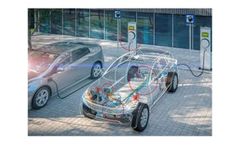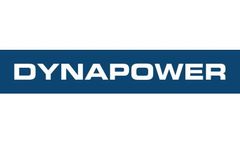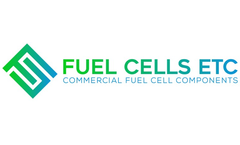Dc And Dc Ac Power Converters Articles & Analysis
33 articles found
As the world works to reduce greenhouse gas emissions, global adoption of electric vehicles (EVs) is driving an increased demand for high-power, energy-efficient compound semiconductors, such as silicon carbide (SiC)-based components, throughout the entire EV assembly process. Renewable energy technology is now at the forefront of climate-forward research, with accelerating EV sales playing a ...
PV is coupled to the DC bus through a DC-DC converter (Dynapower’s DPS-500). Reverse DC-coupled PV+S is most often well suited for microgrid application because of its inherent ability to efficiently provide safe and reliable power to an islanded microgrid. ...
Traditional storage plus solar (PV) applications have involved the coupling of independent storage and PV inverters at an AC bus, or alternatively the use of multi-input hybrid inverters. Here we will examine how a new cost-effective approach of coupling energy storage to existing PV arrays with a DC-to-DC converter can help maximize production and profi ts for existing and new utility-scale ...
This paper presents the design, control and performance of a low power standalone solar–photovoltaic (PV) energy generating system. The system includes a maximum power point tracking (MPPT) controller along with a full bridge DC–DC converter, an energy storage system and a voltage source inverter (VSI). The detailed design and modelling of the system components are given with incremental ...
This paper presents a performance analysis of grid connected SPV system for different maximum power point tracking (MPPT) algorithms. The detailed mathematical model of grid connected three–phase solar photovoltaic (SPV) system with parametric model of SPV cell, thermal modelling and switching loss calculation of switching devices are discussed. The performance evaluation has been carried out for ...
In this paper, the nonlinear phenomenon in DC/DC buck converter is studied. A practical design for a DC/DC buck converter was considered in this study, which results in a more comprehensive understanding for the phenomenon. The nonlinearity of the buck converter is studied using the iteration mapping technique. The results showed that if the system has a well–designed buck converter as well as a ...
Hybrid energy storage system (HESS) can be adopted in hybrid, plug–in hybrid, and pure electric vehicles (HEV, PHEV, and EV), where a bidirectional DC–DC converter (BDC) is used to connect batteries and ultra–capacitors. The efficiency improvement of the BDC is beneficial to increase the efficiency viability of HESS. Due to ZVS, high efficiency can be obtained at heavy load operations while the ...
In this paper, bond graphs are employed to develop a novel mathematical model of conventional switched–mode DC–DC converters valid for both continuous and discontinuous conduction modes. A unique causality bond graph model of hybrid models is suggested with the operation of the switch and the diode to be represented by a modulated transformer with a binary input and a resistor with fixed ...
A modern maximum power point tracking (MPPT) method based on the incremental conductance (IncCond) control algorithm is discussed. This method features a variable step iteration of duty ratio to get over the trade–off between dynamic performance and steady state oscillation around maximum power point (MPP). Moreover, in the aim to get an excellent precision and a swift response independently of ...
A power factor corrected (PFC) bridgeless converter–based computer power supply (CPS) using multioutput flyback dc–dc converter is presented in discontinuous conduction mode (DCM) of operation. In place of the conventional diode bridge to convert ac voltage into ...
This paper presents the implementation of feedforward in digital domain to meet the audio susceptibility as per MIL STD 461C for voltage mode digitally controlled DC-DC converters. The feed-forward is accomplished through the estimation of duty ratio based on the input voltage at every switching cycle. The prototype converter developed is having galvanic isolation in the forward and feedback ...
An automatic calibration method for a previously proposed sensorless adaptive voltage positioning (SLAVP) controller is presented in this article. The SLAVP scheme achieves AVP control without the need for current sensing and sampling required by conventional AVP schemes. However, the accuracy of the SLAVP control scheme is sensitive to the power path equivalent DC resistance value, R eq . ...
In this paper, a new topology of single-phase pulse width modulated (PWM) AC-DC converter is proposed for bidirectional power flow between plug-in hybrid electric vehicle (PHEV) and the grid. ...
A home area network (HAN) incorporating a high–power high–efficiency charging/discharging battery system is capable of executing energy saving strategies in the smart grid, such as TOU or DR. This paper presents a bidirectional isolated DAB–based DC/DC converter for a Li+Fe battery system in the HAN. Battery energy is controlled by the phase angle between the primary bridge and the secondary ...
High–frequency transformer isolated DC–to–DC converters are widely used for power conversion in alternate energy and other applications. In such applications, it is important for the converter to operate with wide variations in input voltage. A hybrid phase modulated converter (HPMC) can achieve this with soft–switching characteristics. This paper presents the analysis of such a hybrid phase ...
The first stage of this SMPS consists of a 6–pulse diode bridge converter that performs ac–dc conversion yielding an unregulated dc voltage. In the second stage, two boost rectifiers are connected together which feed to a boost dc–dc full bridge converter connected to the output ...
A 360 W photovoltaic (PV) module power with a maximum power point tracking (MPPT) algorithm is analysed and presented. In this study, the control algorithm is improved and then applied to the PV system. The results obtained show the ability of this algorithm to control high powers when weather conditions are changing. Under the same conditions, this improved technique offers, in steady state ...
This paper presents the modelling and control of fuel cell–based distributed generation system with embedded active filter functioning. It includes the modelling of proton electrolyte membrane fuel cell and the power conditioning unit interfacing the fuel cell to the utility grid with proper power flow control. The output of the fuel cell stack is given to the DC–DC boost converter ...
The application range of traditional thin–film transistor (TFT) liquid–crystal display (LCD) drivers powered by switched–capacitor DC–DC converters (charge pumps) used in portable devices are, to a certain extent, restricted because of their inability to support applications that require high driving current for generating high resolution graphics or powering larger LCD panels. This paper reviews ...
As with Electrolyzers on my previous post, there are many nuances in the optimal design of a Fuel Cell. The proper selection depends on the application, type of fuel cell, component selection and design (MEAs, flow fields, etc.) and a host of other factors. However, I will start with a simple tool that will help determine some general characteristics of a typical H2/Air fuel cell. Thanks to ...




